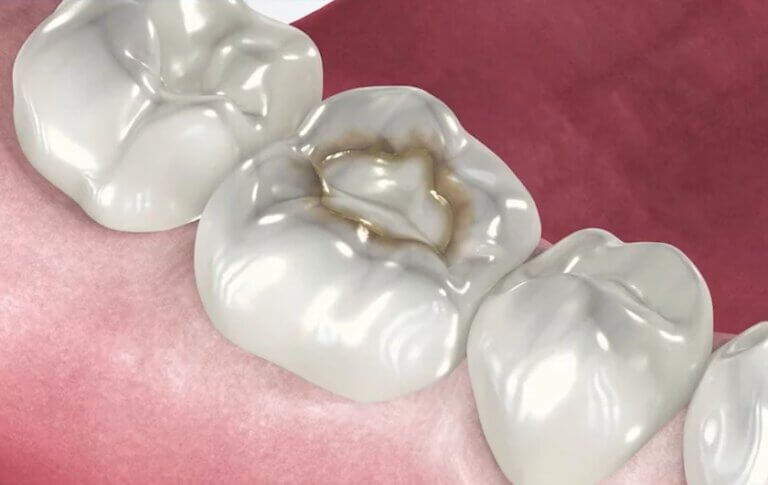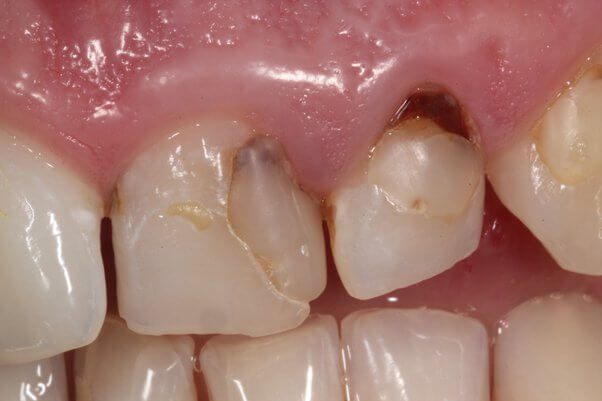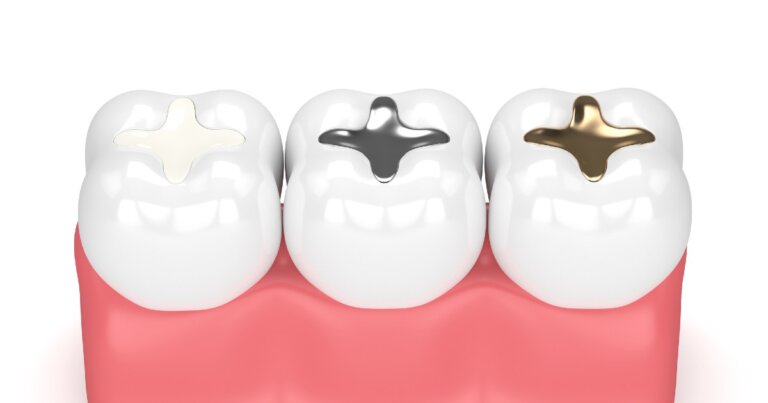A Cavity Under An Old Filling

What Is A Cavity Under An Old Filling?
If you have ever had a dental filling, you might assume that once the tooth filling is in place, you can forget about it. However, dental fillings are not always permanent, and they may need to be replaced over time. One common reason for replacing a filling is due to the development of a cavity underneath it.
A cavity or tooth decay under an old filling occurs when bacteria accumulate in the space between the filling and the tooth, causing decay to form. This can happen if the tooth filling is old and beginning to wear down, or if there was an issue with the initial placement of the dental filling. In either case, if the cavity is left untreated, it can lead to further damage to the tooth, such as infection or a larger cavity that may require more extensive treatment.
If you suspect that you may have a tooth decay under an old filling, it’s essential to seek dental care promptly to prevent further damage to your tooth. Before you contact a Toronto dentist to examine A Cavity Under An Old Filling, there are some things you should know as a patient:
- Why Do I Have A Cavity Under An Old Filling?
- Signs And Symptoms Of A Cavity Under An Old Filling
- Treatment Options For A Cavity Under An Old Filling
- How To Prevent A Cavity Under An Old Filling?
- Managing A Cavity Under An Old Filling Until You Can See The Dentist
If you have questions about A Cavity Under An Old Tooth Filling or other dental problems, please contact us for more information.
Why Do I Have A Cavity Under An Old Filling?
There are several reasons why a cavity can form under an old filling, including:
- Poor oral hygiene: Poor oral hygiene can lead to the buildup of plaque and tartar on teeth, which can cause decay to form underneath an existing dental filling.
- Age of filling: Over time, dental fillings can begin to wear down or crack, creating gaps between the filling and the tooth that bacteria can enter, leading to tooth decay and a cavity.
- Improper filling placement: If the tooth filling was not properly placed, it can create gaps between the filling and the tooth, allowing bacteria to enter and cause decay.
- Diet: A diet high in sugar and carbohydrates can lead to an increased risk of tooth decay, which can lead to a cavity under an old filling.
It’s essential to maintain good oral hygiene and visit your dentist regularly for check-ups and cleanings to prevent cavities and catch any issues early on before they worsen. If you have further questions about A Cavity Under An Old Dental Filling, please contact us.
Signs And Symptoms Of A Cavity Under An Old Filling
If you have an old dental filling, it’s essential to watch out for signs and symptoms of a cavity developing underneath it, including:
- Tooth sensitivity: Sensitivity to hot, cold, or sweet foods and drinks may indicate that the tooth has developed tooth decay underneath the tooth filling.
- Pain or discomfort: Pain or discomfort when biting down or applying pressure to the tooth may be a sign of a cavity under the dental filling.
- Visible damage to the tooth filling: If you can see cracks or chips in the filling, or if it appears to be discolored, it may be a sign that a cavity has formed underneath it. Alternatively, the tooth itself may appear discolored.
- Pus or discharge: If you notice pus or discharge around the affected tooth, it may indicate that an infection has developed due to a cavity under the filling.
- Halitosis: Bad breath may be a sign of an infection caused by tooth decay under the filling.
If you experience any of these symptoms, it’s important to schedule an appointment with your dentist as soon as possible to determine the cause of the problem and get appropriate treatment. Early detection and treatment can help prevent further damage to your tooth and potentially more extensive treatments. If you have further questions about signs and symptoms of A Cavity Under An Old Filling, please contact us.

Treatment Options For A Cavity Under An Old Filling
If you have a cavity under an old dental filling, there are several treatment options available, including:
- Replacement with a new filling: The dentist will remove the old tooth filling and clean out the decayed area underneath. Once the decayed area has been cleaned out, the dentist will place a new filling in the tooth. The filling material used will depend on the size and location of the tooth decay.
- Root canal therapy: In some cases, the cavity may be so large that it has affected the nerve of the tooth, and a root canal may be necessary. This involves removing the damaged nerve tissue and tooth filling the space with a special material to prevent infection.
- Dental crown: If the cavity is large and has weakened the structural integrity of the tooth, a dental crown may be necessary to provide additional support and prevent further damage.
- Tooth extraction: In severe cases where the tooth is too damaged to save, the tooth may need to be removed. Tooth replacement options include dental implant, dental bridge, or denture.
The best treatment option for tooth decay under an old dental filling will depend on the extent of the damage to the tooth. It’s important to seek prompt dental care to prevent further damage and to discuss the most appropriate treatment options with your dentist. If you have further questions about treatment options for A Cavity Under An Old Filling, please contact us.
How To Prevent A Cavity Under An Old Filling?
Preventing a cavity under an old dental filling requires good oral hygiene and regular dental check-ups. Here are some tips to help prevent cavities from forming underneath your old fillings:
- Brush and floss regularly: Brush at least twice a day with fluoride toothpaste and floss daily to remove plaque and food particles from between your teeth.
- Use mouthwash: Using an antimicrobial mouthwash can help reduce the number of bacteria in your mouth.
- Limit sugary and acidic foods and drinks: Consuming sugary and acidic foods and drinks can increase the risk of developing cavities. Try to limit these types of foods and drinks in your diet.
- Visit your dentist regularly: Regular dental check-ups can help detect cavities and other dental issues early on, making them easier to treat.
- Replace old dental fillings: Over time, fillings can wear down, crack, or become damaged, creating gaps where bacteria can enter and cause decay. Replacing old fillings can help prevent cavities from forming.
By following these simple tips, you can help prevent cavities from forming underneath your old fillings and maintain good oral health. Do not hesitate to contact your dentist if you notice any signs or symptoms of tooth decay under an existing filling, as early detection and treatment can prevent further damage to your tooth. If you have further questions about how to prevent A Cavity Under An Old Filling, please contact us.

Managing A Cavity Under An Old Filling Until You Can See The Dentist
If you suspect that you have a cavity under an old dental filling and cannot see your dentist right away, here are some tips to manage the issue until your dental appointment:
- Practice good oral hygiene: Keeping the area around the old dental filling as clean as possible can help prevent further decay and alleviate some of the pain or sensitivity. Brush and floss gently around the tooth. Rinsing your mouth with warm salt water or mouthwash can help reduce infection, inflammation and alleviate toothache pain. You can buy any mouthwash available at your pharmacy or health foods store. Alternatively, you can mix a teaspoon of salt in a cup of warm water and swish the solution around your mouth for about 30 seconds before spitting it out.
- Use Over-the-Counter Pain Medication: Over-the-counter pain medication, such as Advil (ibuprofen) or Tylenol (acetaminophen), can help relieve tooth pain or sensitivity from tooth decay under a an old dental filling. Follow the instructions on the label and do not exceed the recommended dose. Unless you have a health condition that prevents you from taking either ibuprofen or acetaminophen, the absolute maximum dose that I recommend patients take for the worst dental pain is 600 mg ibuprofen combined with 1000 mg acetaminophen every 4 to 6 hours.
- Avoid sugary and acidic foods and drinks: Sugary and acidic foods and drinks can worsen the tooth decay and cause further damage. Try to avoid them until you can see your dentist.
While these tips can help manage a cavity under an old tooth filling until you can see your dentist, it’s important to seek professional dental care as soon as possible to prevent further damage and complications. Your dentist will be able to provide appropriate treatment options based on the extent of the damage to your tooth. If you have further questions about managing A Cavity Under An Old Filling, please contact us.

